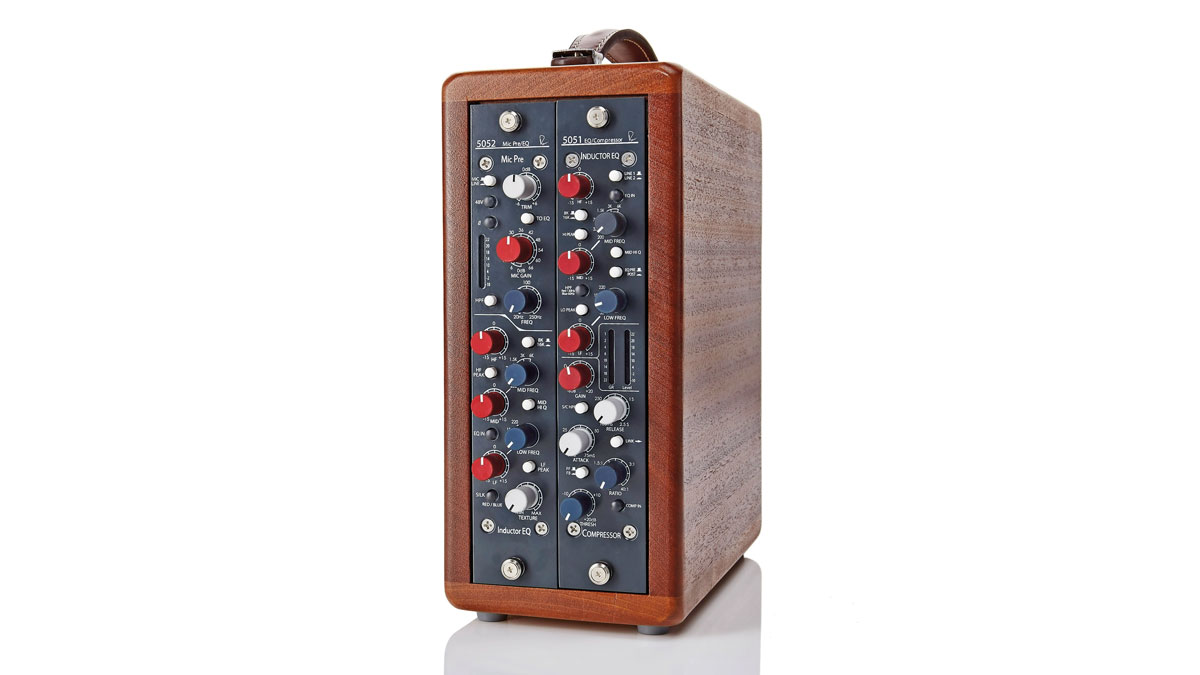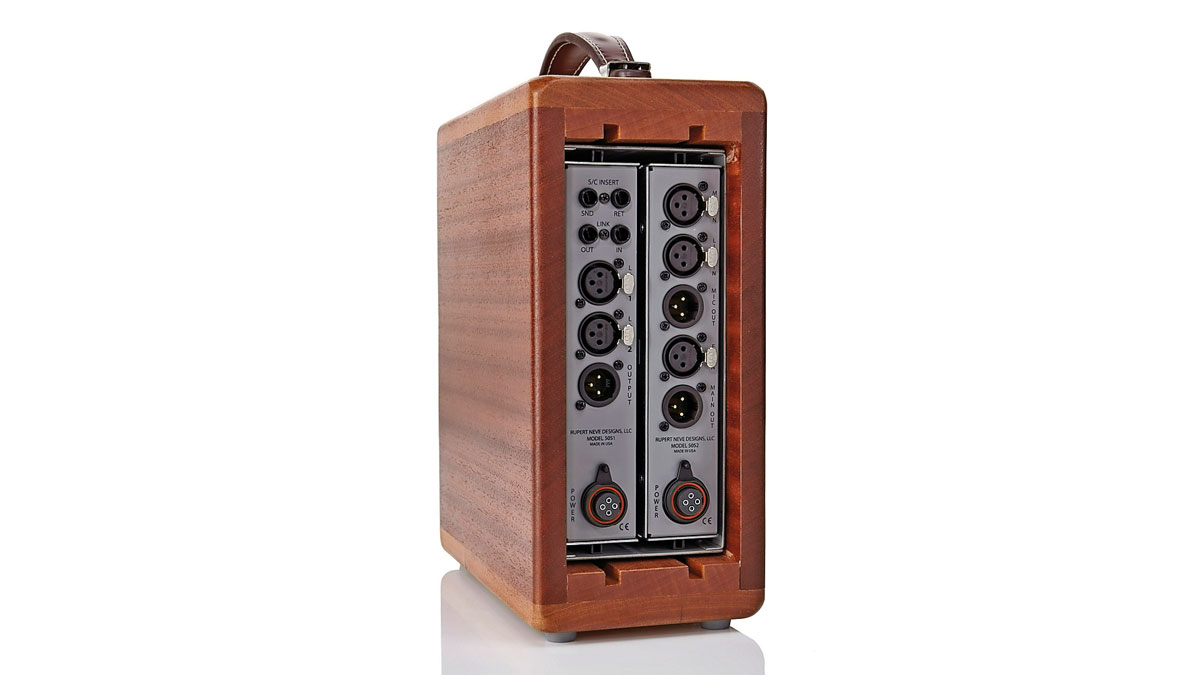MusicRadar Verdict
Stylish, awesome analogue circuitry with quite possibly the fattest mic pre you'll ever encounter.
Pros
- +
Solid smooth mic pre with lots of gain. Characterful, musical EQ. Beautiful construction and rack case.
Cons
- -
Past the price, not much.
MusicRadar's got your back

Rupert Neve Designs Shelford 5051 and 5052

Rear
RND's latest products see a return to classic transformer-based designs and mark 50 years since Mr Neve developed his 80 Series modules in a converted rectory in Little Shelford.
The suitably titled Shelfords are a pair of modules with external power supply. The 5051 includes an inductor-based EQ and a compressor, while the 5052 is a mic pre and inductor EQ. Neither is a slavish recreation of the classic Series 80 modules (1073, 1081, 1064 and so on).
Also worth noting is that the modules are not designed for use in a vintage desk. Audio connectivity is on XLRs and balanced jacks, with power supplied on proprietary screw-in 4-pin connectors.
"When boosting, the bell shape is quite broad and is very musical, but in cut it's much narrower and ideal for notching out nastiness"
Our review package includes the upright 2-Way Wood Rack and the 5-Way power Supply, but for the serious investor there's also a 25-Way (2U) Power Supply and 9-Way (6U) Metal Rack with rack ears.
The Shelfords are Class-A discrete designs that use a high voltage (+/-24V) power supply, and incorporate custom wound transformers and inductors. Both modules cherry pick specific Neve designs, creating new hybrids.
The units share an EQ design (although the 5051 also includes a high-pass filter), so between the two Shelfords you've effectively got four circuits to consider - a mic pre which also incorporates a line input option and high-pass filter (HPF), a three-band EQ, a compressor and a version of the Silk circuit similar to RND's Portico II Channel.
In terms of signal flow and connectivity, the units work as follows. The 5051's default mode is Inductor EQ followed by Compressor, and the EQ can be switched post Compressor.
There are two Line Input connections on the back and one main Output (all on XLR), and the two inputs are simply there for convenience, with a selector at the top of the front panel.
In its default state, the 5052 offers two separate signal paths, the Mic Pre/Line Input with HPF, and the three-band EQ with Silk option. The Mic and Line In and Mic Out connectors (all on XLR) access the former, with the EQ In and Main Out connectors (also on XLR), accessing the EQ. To use the 5052 as one signal path (Mic Pre then EQ) simply select ToEQ.
Fat sounds
Based on the 1064 LF band, the Shelford LF (35Hz, 60Hz, 100Hz and 220Hz) includes peak as well as shelving modes. With +/-15dB gain and a gentle slope it's ideal for adding broad low-end girth and we particularly like the 35Hz and 60Hz options as they leave the low mids reasonably untouched.
In LF Peak mode you can be more focused but these are fairly broad on boost and cut. The Shelford inductor MF band is based on the 1073 EQ, although the Shelford's six frequencies (200Hz, 350Hz, 700Hz, 1.5kHz, 3kHz and 6kHz) are slightly different.
What's great with this circuit is, when boosting, the bell shape is quite broad and is very musical, but in cut it's much narrower and ideal for notching out nastiness. This is even more pronounced in the Mid Hi Q mode. The HF band also takes its lead from the 1073 inductor design, but with its own frequencies (8kHz and 16kHz) and additional HF Peak mode.
"The sound is amazingly present and detailed with a low mid richness that's missing from many mic pres"
Once again, the peak mode is nice and broad, and we found the difference between each mode subtle. Finally, set at either 60Hz or 120Hz, the 5051's 18dB/octave high-pass filter works well in conjunction with the LF band.
Silk has two options, Red and Blue, which combine with the Texture (amount) control. Increasing Texture reduces the negative feedback at the output transformer resulting in extra harmonic distortions. In general terms we found Red added more mid range presence, while Blue very subtly thickened up the low mids.
The Compressor is a hybrid design nabbed from units such as the Portico 5043. Designed to be pretty transparent, the key feature is feedback and feed forward modes. This makes for a wonderfully flexible design capable of punchy snap compression, laid-back gluing duties and lots in between.
There's also a sidechain high-pass option (250Hz) that's useful with bass heavy signals, and you can patch into the sidechain loop on the back panel too.
Finally, the Mic Pre. Although we've left this until last, it is one of my favourite aspects of this design. First, 72dB of gain (achieved using 66dB on the Mic Gain and +6dB on the Trim), is enough to keep anyone happy.
Next, the sound is amazingly present and detailed with a low mid richness that's missing from many mic pres. The full flexible HPF (20Hz-250Hz) is ideal for tailoring mic proximity and removing rumble.
The Shelfords aren't slavish recreations, nor are they all-singing, alldancing channel strips (RND's Portico II Channel has that covered). For us a DI option on the 5052 would make sense but, aside from this minor gripe, we absolutely love them. Creamy, fat and solid sonically, expertly constructed and beautifully presented. Wow.
Jon is a London based platinum award winning mixer, producer, composer and club remixer with a diverse CV that spans dance, pop, rock and music for media. He’s also a long term contributor to MusicRadar's music technology tutorials and reviews. Whether working alone or collaborating he usually handles final mixdowns, so you’ll also find MusicRadar peppered with his handy mixing tips.
“It’s about delivering the most in-demand mods straight from the factory”: Fender hot-rods itself as the Player II Modified Series rolls out the upgrades – and it got IDLES to demo them
“For some reason, the post office shipped your guitar to Jim Root of Slipknot”: Sweetwater mailed a metal fan's Jackson guitar to a metal legend
"No one phoned me. They never contacted me and I thought, 'Well, I'm not going to bother contacting them either'": Ex-Judas Priest drummer Les Binks has died aged 73










